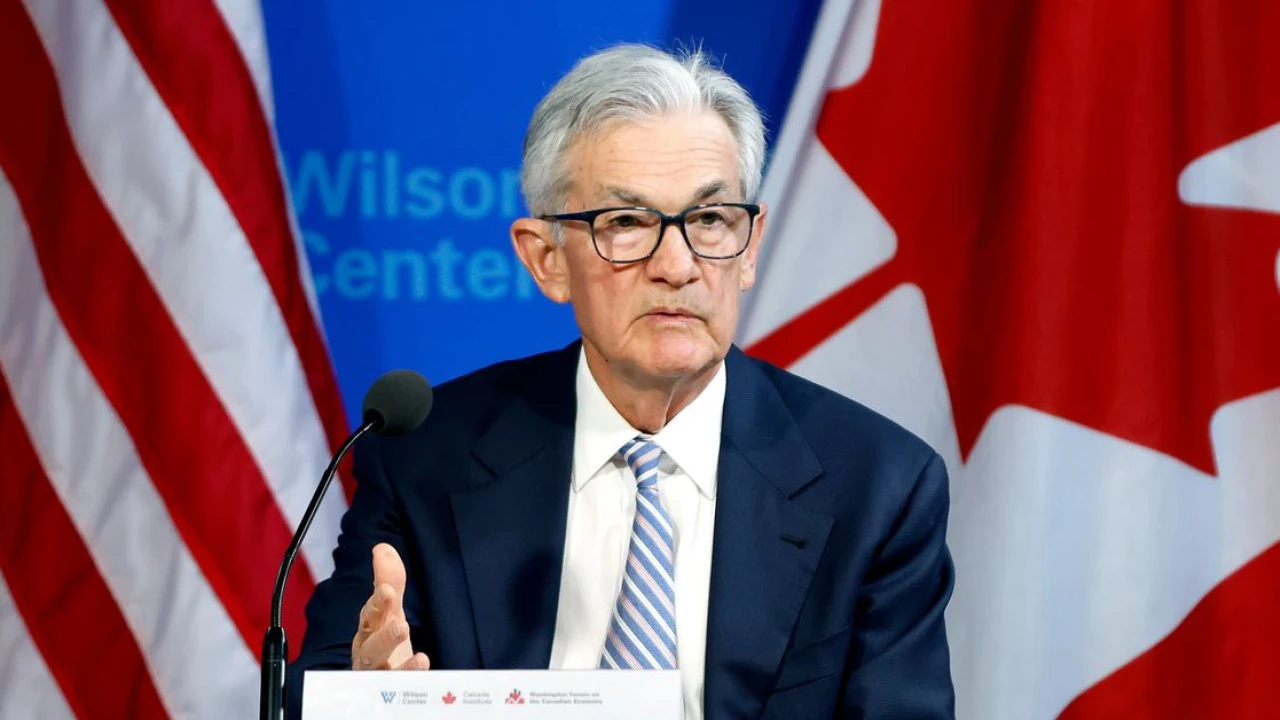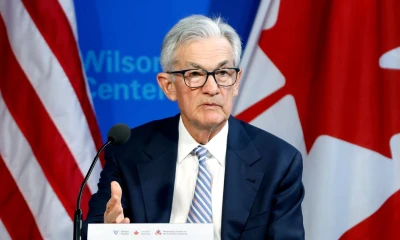Regional
High interest rates probably aren’t going away anytime soon
The Federal Reserve will give an announcement on interest rates during its May meeting Wednesday. But inflation is still high, so don’t get your hopes up.

Even borrowing money is more expensive these days — and the Federal Reserve might decide to keep it that way for a while.
All eyes are on the Fed’s May meeting today, where Fed chair Jerome Powell will make an announcement about interest rates. Though analysts do not expect the Fed to cut rates just yet, some had projected a cut might be coming soon. That now appears increasingly unlikely.
Instead, his remarks are expected to shed light on how much longer the US economy will have to endure high interest rates, which are squeezing everyone from prospective home buyers to people who have racked up credit card debt.
High interest rates have helped cool a too-hot economy, significantly bringing down inflation to 3.5 percent from its 9.1 percent peak in June 2022. But it’s still well above the Fed’s target rate of 2 percent, and inflation has increased slightly in the last few months, which means we might not see a rate cut anytime soon.
“The ‘last mile’ ... to the Fed’s target range was expected to be more difficult than what came before it,” said Matt Colyar, an economist at Moody’s Analytics. “Even with that expectation, however, inflation data in the first three months of 2024 has been surprisingly high.”
Why inflation has remained high
A few factors are driving stubborn inflation.
Housing costs have been the biggest contributor by far. Inflation in rent and homeowners’ cost of living in their own homes has moderated somewhat but by less than expected, Colyar said. Auto insurance and repair costs have also risen sharply even though car prices have fallen. And health care costs have also picked up.
:no_upscale()/cdn.vox-cdn.com/uploads/chorus_asset/file/25427523/wCG9h_inflation_has_been_stubborn__3_.png)
But this isn’t necessarily a “strong indication that inflation will remain similarly high for the rest of 2024,” Preston Caldwell, chief US economist at Morningstar, said in a note to investors Friday.
The US economy has so far staved off a recession, growing at a slower but still solid pace in the first quarter of 2024 in part because Americans are continuing to spend a lot. The job market also remains strong, with the US blowing past projections to add 303,000 jobs in March.
That hasn’t given the Fed much urgency to cut rates anytime soon. “It’s not an economy in obvious need of the pick-me-up that a rate cut would deliver,” Colyar said.
Strong consumer spending, though, isn’t expected to last as Americans deplete any savings they accrued in the pandemic and rack up more household debt. That will likely cause US economic growth to slow in the coming year, which “should be sufficient to cool off remaining excess inflation,” Caldwell told Vox.
When will the Fed cut interest rates?
After the Fed’s December meeting, financial analysts were expecting six interest rate cuts in 2024, beginning in June. But given that inflation has remained high and the economy is still going strong, that doesn’t seem to be happening anytime soon.
Caldwell said he’s now expecting three cuts this year starting in September. Other top economists at UBS, Barclays, Goldman Sachs, and Bank of America have also pushed back their projections for a rate cut. For example, Bank of America is projecting only a single rate cut in December.
Some Fed officials also have not ruled out the possibility of another rate hike, which would be the first since last July. Fed Governor Michelle Bowman recently said she would support a rate hike “should progress on inflation stall or even reverse.”
But Caldwell said that still seems a far-off possibility. “The mere fact that they’re delaying rate cuts already has a contractionary effect on the economy,” he said.
Colyar said he will be watching Powell’s remarks to discern “how spooked they have been by the hotter-than-expected inflation data in the first quarter” and to what extent he attributes the stickiness of inflation to a few industries, rather than an indication of current overall cost pressures.
What continued higher interest rates might mean for the economy
Recent economic data has already dampened earlier enthusiasm in the stock market about an imminent interest rate cut. Powell’s remarks might have a similar depressive effect, depending on how pessimistic he is about the Fed winning its battle against inflation in the near term.
“The first effect is psychological,” Colyar said. “Persistently high borrowing costs are painful and will eventually break something.”
It’s already slowing down the real estate market significantly. Mortgage rates have surpassed 7 percent, and that’s keeping prospective home buyers and sellers on the bench. People who secured lower interest rates just a few years ago don’t want to sell and would have to secure a higher-rate mortgage for their new lodging, so there are fewer homes on the market, keeping prices higher than many buyers can afford.
Americans’ total credit card debt also hit a record $1.13 trillion earlier this year, and repaying that in a high interest rate environment is bound to hurt their wallets.
At the same time, the US economy has proved resilient even in a high interest rate environment. The Fed doesn’t need to step in just yet given steady job growth and economic growth, as well as strong consumer spending.
“However, I would argue that the time to start loosening policy is before things are flashing red,” Colyar said. “Waiting too long because shelter prices are slow in moderating I think is an unnecessary risk.”
This story appeared originally in Today, Explained, Vox’s flagship daily newsletter. Sign up here for future editions.
Business
Oil sets at steepest weekly loss in three months
Brent crude futures for July settled 71 cents lower, or 0.85%, to $82.96 a barrel

New York: Oil prices settled lower on Friday, and posted their steepest weekly loss in three months as investors weighed weak US jobs data and possible timing of a Federal Reserve interest rate cut.
Brent crude futures for July settled 71 cents lower, or 0.85%, to $82.96 a barrel. US West Texas Intermediate crude for June fell 84 cents, or 1.06%, to $78.11 a barrel.
Investors were concerned that higher-for-longer borrowing costs would curb economic growth in the US, the world's leading oil consumer, after the Federal Reserve decided this week to hold interest rates steady.
For the week, Brent declined more than 7%, while WTI fell 6.8%.
US job growth slowed more than expected in April and the annual wage gain cooled, data showed on Friday, prompting traders to raise bets that the US central bank will deliver its first interest rate cut this year in September.
The Fed held rates steady this week and flagged high inflation readings that could delay rate cuts. Higher rates typically weigh on the economy and can reduce oil demand.
The market is repricing the expected timing of possible rate cuts after the release of softer-than-expected monthly jobs data, said Giovanni Staunovo, an analyst at UBS.
US energy companies this week cut the number of oil and natural gas rigs operating for a second week in a row, to the lowest since January 2022.
The oil and gas rig count, an early indicator of future output, fell by eight to 605 in the week to May 3, in the biggest weekly decline since September 2023. The number of oil rigs fell seven to 499 this week, in the biggest weekly drop since November 2023.
Geopolitical risk premiums due to the Israel-Hamas war have faded as the two sides consider a temporary ceasefire and hold talks with international mediators.
Further ahead, the next meeting of OPEC+ oil producers - members of the Organisation of the Petroleum Exporting Countries and allies including Russia - is set for June 1.
Three sources from the OPEC+ group said it could extend its voluntary oil output cuts beyond June if oil demand does not increase.
Money managers cut their net long US crude futures and options positions in the week to April 30, the US Commodity Futures Trading Commission (CFTC) said.
SOURCE: REUTERS
World
Canadian police charge three Indians in Sikh leader Nijjar’s murder
The Indian mission in Ottawa did not respond to requests for comment

Ottawa: Canadian police on Friday arrested and charged three Indian men with the murder of Sikh separatist leader Hardeep Singh Nijjar last year and said they were probing whether the men had ties to the Indian government.
Nijjar, 45, was shot dead in June outside a Sikh temple in Surrey, a Vancouver suburb with a large Sikh population. A few months later, Canadian Prime Minister Justin Trudeau cited evidence of Indian government involvement, prompting a diplomatic crisis with New Delhi.
The Royal Canadian Mounted Police named the three men as Karanpreet Singh, 28, Kamalpreet Singh, 22 and Karan Brar, 22.
"We're investigating their ties, if any, to the Indian government," Mandeep Mooker, an RCMP superintendent, told a televised news conference.
The Indian mission in Ottawa did not respond to requests for comment.
Nijjar was a Canadian citizen campaigning for the creation of Khalistan, an independent Sikh homeland carved out of India. The presence of Sikh separatist groups in Canada has long frustrated New Delhi, which had labeled Nijjar a "terrorist".
Last week the White House expressed concern about the reported role of the Indian intelligence service in assassination plots in Canada and the United States.
The three individuals charged with first-degree murder and conspiracy to commit murder in relation to the murder in Canada of Sikh separatist leader Hardeep Singh in 2023, are seen in a combination of undated photographs released by the Integrated Homicide Investigation Team (IHIT).
Canadian police said they had worked with US law enforcement agencies, without giving additional details, and suggested more detentions might be coming.
"This investigation does not end here. We are aware that others may have played a role in this homicide and we remain dedicated to finding and arresting each one of these individuals," said Assistant RCMP commissioner David Teboul.
The trio, all Indian nationals, were arrested in the city of Edmonton in Alberta on Friday, police said. They are due to arrive in British Columbia by Monday.
Trudeau announced in September that Canadian authorities were pursuing allegations linking Indian government agents to the murder. New Delhi rejected Trudeau's claim as absurd.
"We welcome the arrests but this does lead to a lot more questions," said Balpreet Singh, legal counsel and spokesperson for the Canada-based World Sikh Organization advocacy group.
"Those who have been arrested are part of a hit squad but it's clear that they were directed," he said by phone.
Canada had been pressing India to cooperate in its investigation. Last November, US authorities said an Indian government official had directed the plot in the attempted murder on US soil of Gurpatwant Singh Pannun, a Sikh separatist and dual citizen of the US and Canada.
SOURCE: REUTERS
-

 Technology 1 day ago
Technology 1 day agoAI could risk 17pc of jobs in Saudi Arabia: experts
-

 Sports 1 day ago
Sports 1 day agoPakistani squad for Ireland, England series announced
-

 Regional 19 hours ago
Regional 19 hours agoPress Club president killed, nine wounded in Khuzdar bomb blast
-

 Pakistan 1 day ago
Pakistan 1 day agoPM's Saudi Arabia visit to deliver positive results in few months: Tarar
-

 Pakistan 14 hours ago
Pakistan 14 hours agoPPP nominates Kundi, Haider for KP, Punjab governorship
-

 Regional 1 day ago
Regional 1 day agoMagnitude 4.2 quake hits Turbat in Balochistan
-

 Pakistan 1 day ago
Pakistan 1 day agoGovt releases funds to end current passport backlog
-

 Technology 22 hours ago
Technology 22 hours agoPakistan's first satellite mission departs for historic moon journey





















